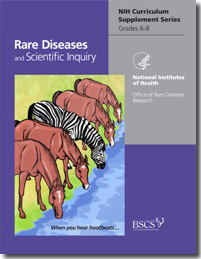NIH Rare Disease Curriculum for Middle School
 For grades 6th, 7th, and 8th, students can explore how scientists use inquiry to research rare diseases and treatments and to further understand the workings of the human body.
For grades 6th, 7th, and 8th, students can explore how scientists use inquiry to research rare diseases and treatments and to further understand the workings of the human body.
The supplement contains two weeks of lessons that can be integrated into existing curriculum and are aligned to national and state standards.
|
Lesson
|
Objectives
|
|---|---|
| 1. What Is a Rare Disease? | Understand the three main causes of diseases (genetics, environmental exposure, and infectious agents) and that rare diseases may become common and common diseases, rare. Recognize that many rare diseases can be cured or managed through treatment. |
| 2. What Causes Rare Diseases? | Examine how two different causes of disease can interact to produce a rare disease. Explore how a common bacterial species can cause a rare disease. |
| 3. The Difficulty of Diagnosis | Observe how problems with a single gene can affect many different body systems. Understand that a rare disease may be difficult to diagnose and that people who are diagnosed with it may have to cope with an associated stigma. |
| 4. The Importance of Medical Research | Perform a simulated Web search and design a clinical trial to understand and treat childhood leukemia. Appreciate that some genetic diseases are inherited and that clinical trials have helped improve treatments for many rare diseases. |
| 5. Communicating about Rare Diseases | Learn about organizations that provide reliable information about rare diseases to the public and understand how such knowledge may reduce the stigma associated with having a rare disease. |
